The opening game of the 2020/21 Serie A season saw Fiorentina take on Torino at the Stadio Artemio Franchi. Torino were going into the new season with a lot of hope due to their new appointment of ex-AC Milan manager, Marco Giampaolo.
The appointment of Giampaolo promised a new style of football at Torino. A style that has not been seen in quite some time. Giampaolo’s teams are very much possession-oriented and rely on structured attacks rather than offensive transitions after soaking up pressure, which they had done under previous managers.
Torino, over the summer, completed a small amount of business, making Simone Verdi’s loan deal permanent. They brought in Karol Linetty, from Sampdoria, who previously worked with Giampaolo, ex-Milan left-back, Ricardo Rodriguez, and Nicolai Murru on-loan, who have also played under Giampaolo. Fiorentina on the other hand have done good business too. They brought in the likes of Borja Valero and Giacomo Bonaventura on free transfers, as well as making permanent transfers for Alfred Duncan, Pol Lirola, and Christian Kouame, for a combined total of around thirty-six million euros.
The game was a tightly contested match, with Fiorentina coming out as narrow 1-0 winners.
This article will be a tactical analysis of Fiorentina’s win. It will be an in-depth analysis of the strengths and weaknesses of both sides in their tactics, throughout the game, as well as taking a look at where each team could have improved in their set-up.
Line-ups and formations:
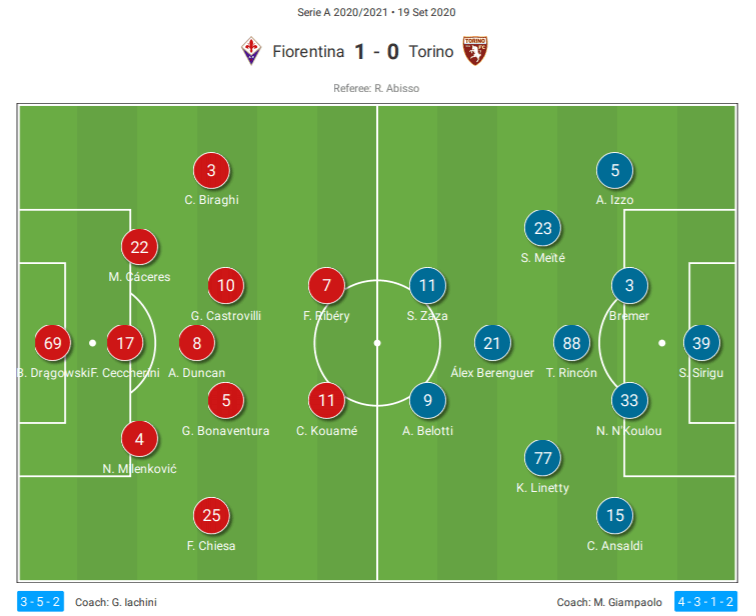
Fiorentina continued to use the same formation that they did in the 2019/20 season under Iachini, in the 3-5-2. The starting goalkeeper was 23-year-old Bartlomiej Dragowski. In front of him was a back three consisting of Martin Caceres, Federico Ceccherini, and Nikola Milenkovic. The wingbacks in the system were the highly-rated Federico Chiesa on the right, as well as an ex-Inter loanee, Cristiano Biraghi.
Fiorentina’s midfield was packed with quality. Alfred Duncan was deployed as holding midfielder, with Gaetano Castrovilli and Bonaventura either side of him. Finally, permanent signing Kouame partnered alongside the experienced, former-Ballon D’or nominee, Franck Ribery, as the forward line. A forward line filled with talent, skill, and pace.
For Torino, it was a complete shift in formation from what they are used to. Giampaolo changed Torino’s system from their usual back three formations to his preferred 4-3-1-2, as predicted.
Salvatore Sirigu started in net, with the back four in front of him consisting of three centre-backs. Armando Izzo was deployed as a right-back in this game, with Gleison Bremer partnering next to Nicolas N’Koulou at centre-back. The attack-minded Cristian Ansaldi was deployed as the left-back to make up the back four, and to give them something going forward.
The three central midfielders were Tomas Rincon in the centre, with Linetty and Soualiho Meite as the wide central-midfielders. Ahead of them, in the ‘number ten’ role was Alex Berenguer, sitting behind the forward line of Andrea Belotti and Simone Zaza.
Torino’s struggles in possession:
Giampaolo is trying to transform Torino into a possession-based team. This means that in possession, there is a great emphasis on building out from the back. Torino, in this match, tried to play out from the back, however, they struggled quite a lot. They are only just getting to terms with the new system and the new style of play.
Against Fiorentina, the possession stats were very close, with Torino having 49 percent of the ball, to Fiorentina’s 51 percent. Only six completed passes separated the sides.
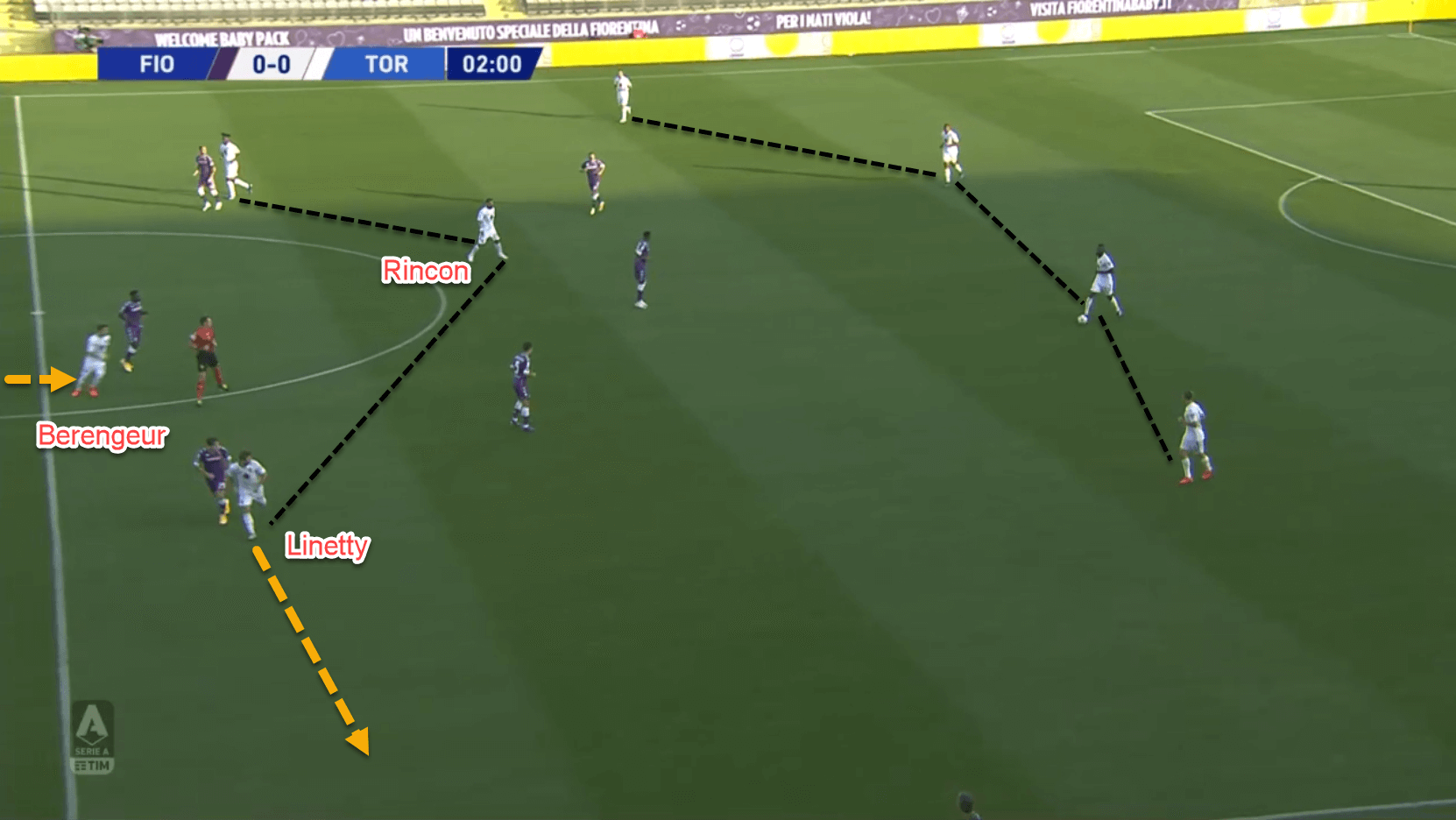
From this image above, we can see Torino’s structure for when they were building out from the back. Giampaolo’s men were forced to be patient on the ball whilst in possession, particularly with their backline. Their backline had to move the ball around trying to find a gap in Fiorentina’s first line of press.
The structure was a 4-3-1-2. They kept their entire backline, including the fullbacks, back to circulate the ball. Rincon was deployed as the single pivot in the team. He maintained his position behind Fiorentina’s front two, drifting to the ball-side in order to act as a progressive passing option.
The more advanced midfielders, Linetty and Meite, moved into the halfspaces in order to stretch the Fiorentina midfield. This left gaps in the central areas for Torino to play into. However, as they did not advance their fullbacks in this phase of play, there was space free on the flanks. When Torino moved the ball to the fullback, their ball-near advanced midfielder would shift into the wide areas. They did this so that they had a wide passing option, but also to free up space for the attacking midfielder, Berenguer, to drop into.
Regardless, due to Fiorentina’s excellent pressing system, Torino struggled massively in their build-up play.
Fiorentina’s zonal and man-oriented pressing system:
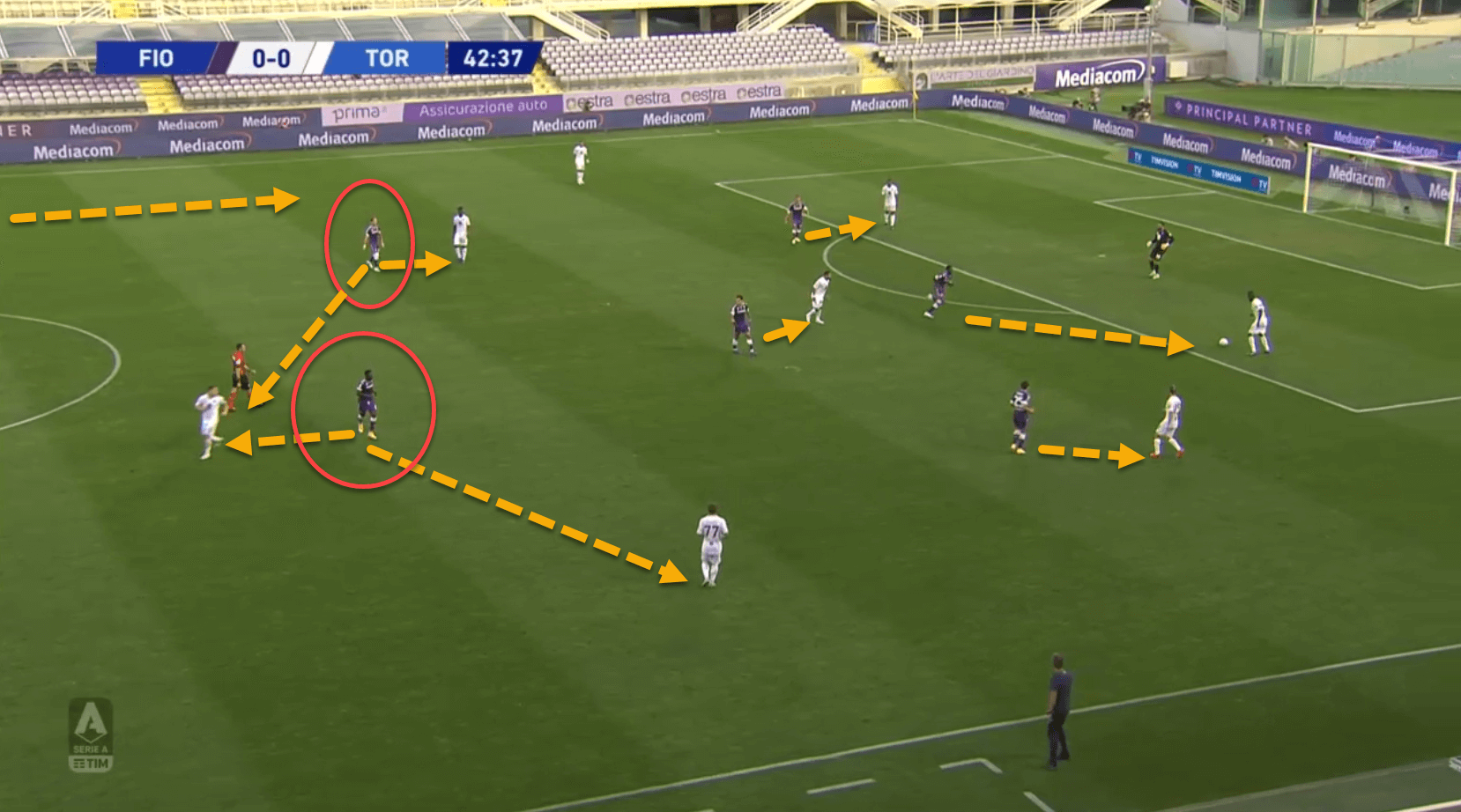
This is generally what Fiorentina’s pressing scheme looked like during Torino’s build-up play. The ball-near wingback would push up and press one of Torino’s fullback. The other wingback would stay back with the three centre-backs and would only engage with his man once the ball was switched to the other fullback. In this instance, it is Chiesa who is pressing Ansaldi, with Biraghi staying back waiting to engage.
The centre-forwards of Fiorentina aggressively pressed Torino’s centre-backs, angling their run to force them to play the ball out wide. Giacomo Bonaventura marked Rincon, trying to force him to play quickly as he did not want Rincon to be able to turn on the ball and play forward.
The zonal marking came into play with Castrovilli and Duncan. They would zonally pick up the nearest man to them. This depended on the ball-side. As you can see in the image above, Torino are about to play the ball to the fullback. Duncan is already moving to pick up Linetty on the flank. This means that he is leaving one zone to go to another. However, he needs cover for his original zone, so Castrovilli will come across to mark it.
Another example of this can be seen in the next image. However, this time, it is on the opposite side of the pitch, with the same pressing system;
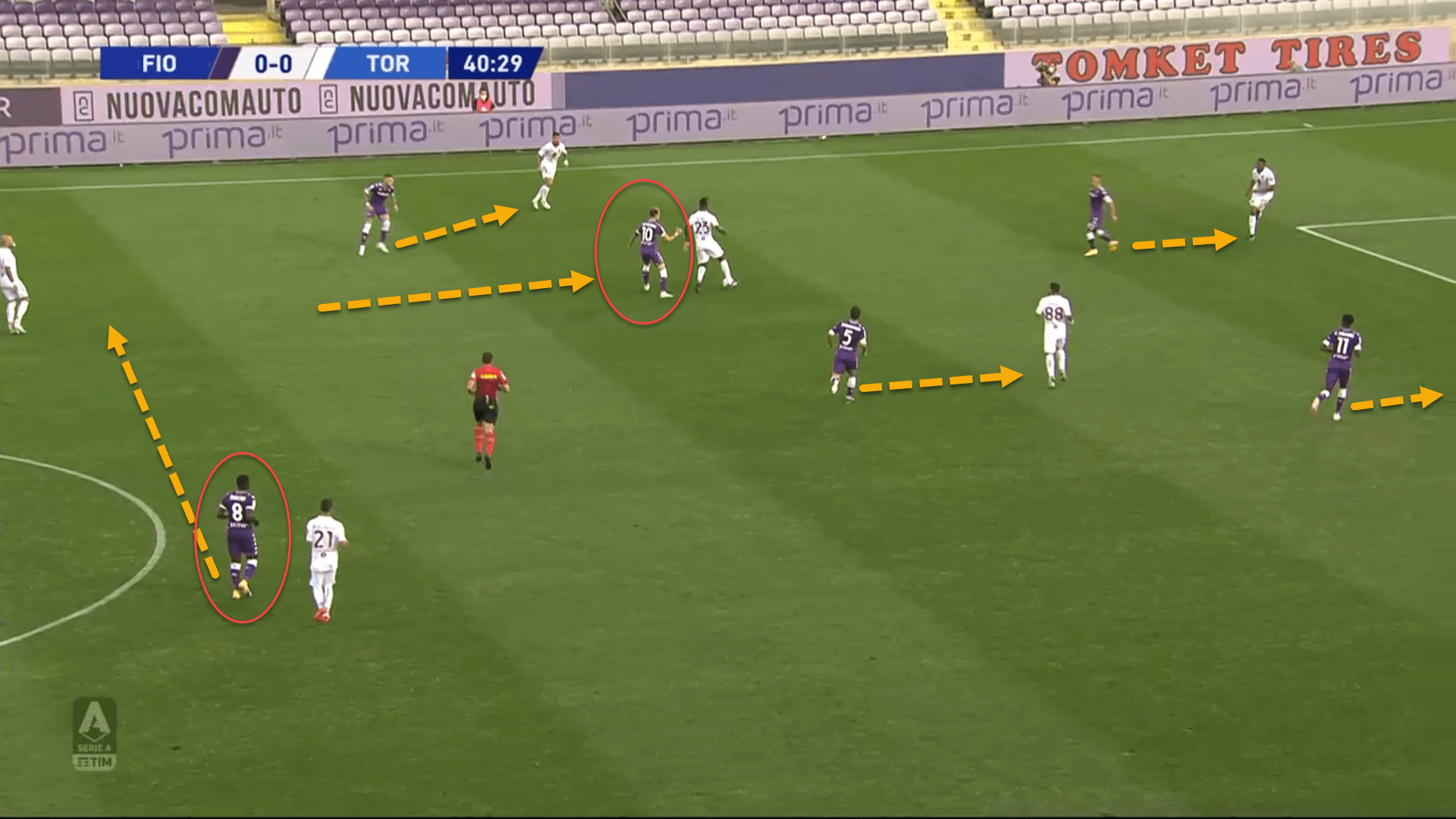
In this image, Biraghi has engaged with the fullback, whilst Castrovilli is the one to leave his zone to mark another player, forcing Duncan to have to cover for him.
Fiorentina had excellent co-ordination and communication in their high press, and Torino struggled massively. They had to constantly play long to their centre-forwards in the hope of them winning the aerial duels. However, they struggled with this also. Belotti and Zaza only won a combined 40 percent of their aerial duels for the entire game.
Fiorentina’s use of Franck Ribery and the wide areas:
One of the key tactical factors of this game was Fiorentina’s use of Ribery, and Torino’s inability to stop him. Despite Ribery’s fine age of thirty-seven, he still produces an excellent amount of quality and skill to be a very good asset for Fiorentina. He no longer possesses the pace that he once had, so has been mainly used as a centre-forward during his time in Italy.
His role in the team is to be a link-up man in all zones of the pitch when his side have the ball in the final third. It is very similar to the role executed by Alexis Sanchez at Inter. Depending on the area of the pitch, he always moves to make himself involved in the play.
Against Fiorentina, Iachini instructed Ribery to continuously drift to the left side of the pitch. From here, he would create a triangle with Biraghi and Castrovilli.
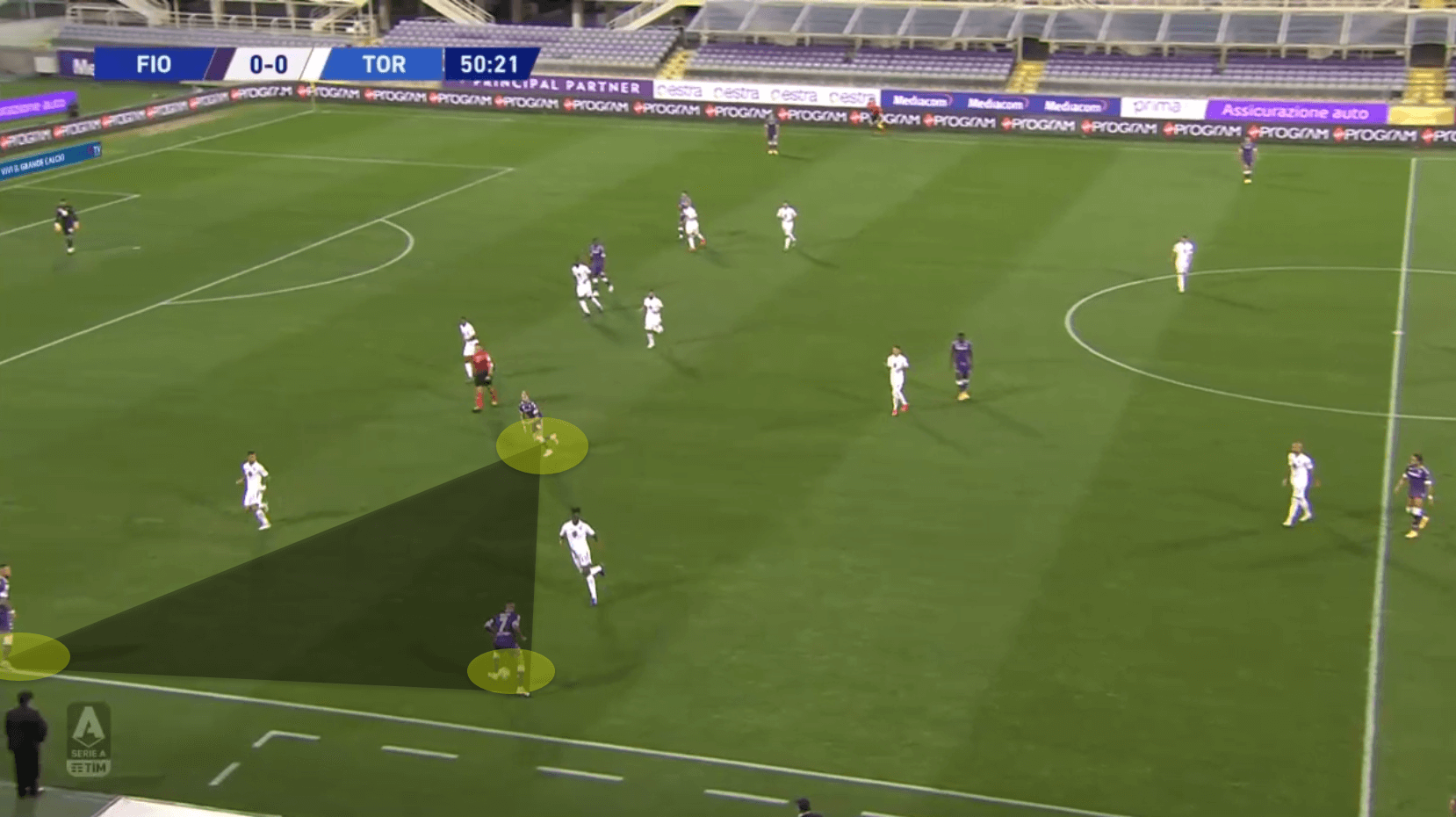
This is an example of the triangle Torino would make with these three players, overloading the left flank. The objective of this overload was to break Torino’s defensive line from this position using quick, incisive passing. From there, they would try to hook an out-swinging ball into the physically strong and tall, Kouame. This worked on several occasions, however, Kouame missed a lot of these chances, from point-blank range headers.
They opted for the left-side as they had better creative options that could break the defensive line, with Ribery and Castrovilli. Biraghi is also an exceptional crosser of the ball, putting in 11 crosses in total throughout the game. Five reached their target.
Iachini’s men had 56 attacks in the whole game. 26 of these attacks were down the left flank, with an xG total of 0.71;
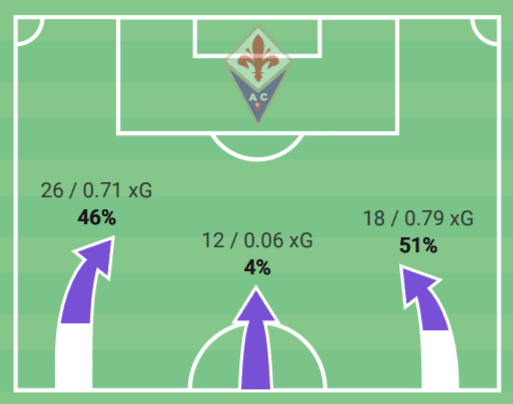
However, as can be seen by the stats above, the left flank was not the only area that they attacked into. 18 of these 56 attacks came from the right flank, with an even higher xG of 0.79. This is where Fiorentina scored the only goal of the game. A combined total of 44 of their 56 attacks were from the flanks, which is an astronomical number.
These numbers were helped by the fact that Torino forced Fiorentina out wide when they defended in their shape;
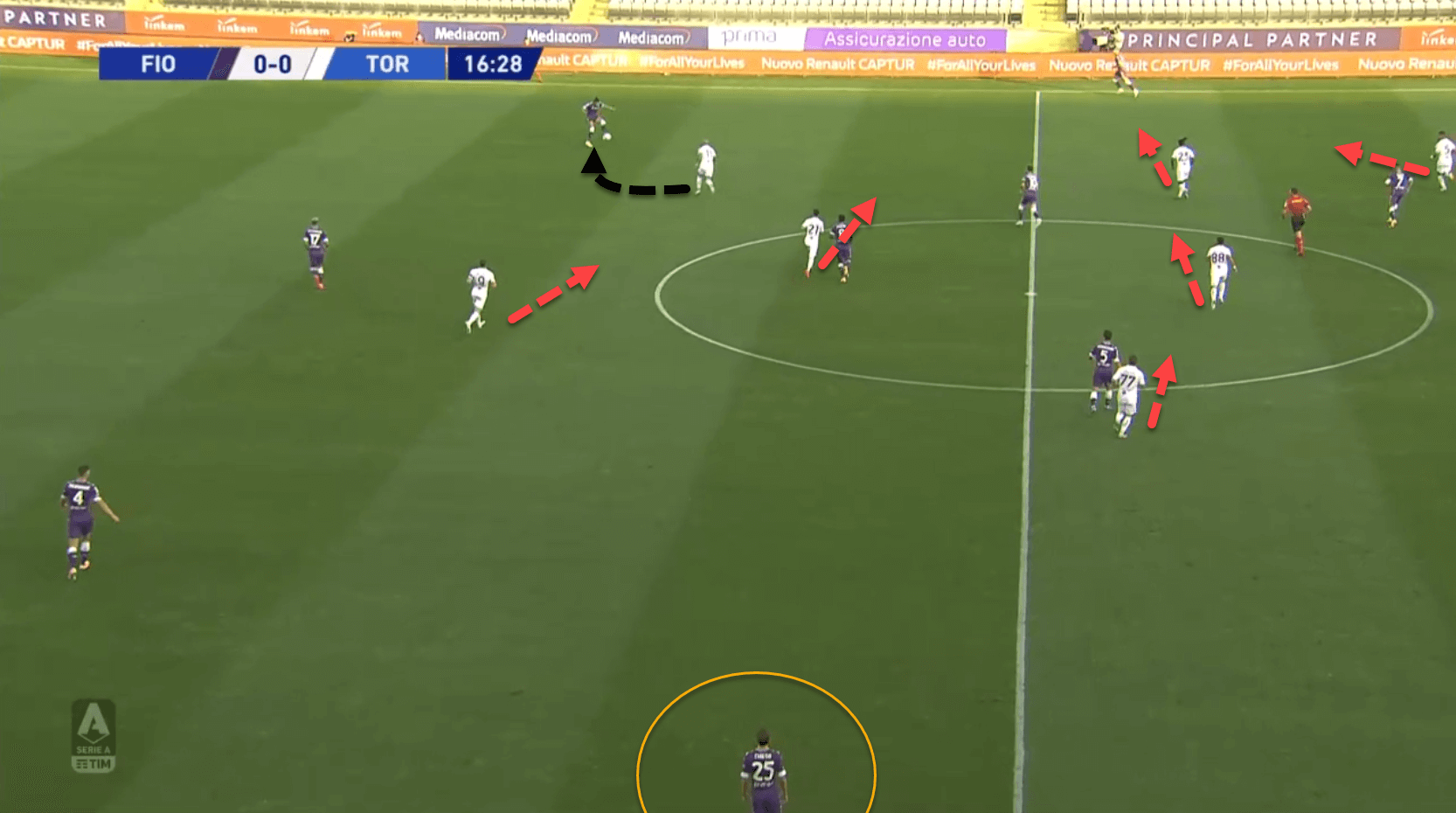
In this footage, we can see by the body shape of Torino’s players, in their defensive 4-3-1-2 mid-block, that they are shifting out to the wide areas. Zaza is angling his run to block off a pass to the nearest centre-back forcing him to play wide.
The main problem with this is that forcing a team who like to play in the wide areas, out wide, is not necessarily the most efficient way of winning the ball back. As Torino were playing with a congested midfield, forcing Fiorentina inside into a compact central area would have been far more efficient.
Another problem with this was that Fiorentina are excellent at switching the play. When they felt it was too dangerous to play into the nearest wide area, the ball-carrier would switch the play over to the opposite wingback, who was always free in acres of space. This was generally Chiesa.
Chiesa was the main contributor to Fiorentina’s attacks down the right. He possesses excellent dribbling ability, winning 60 percent of his dribbles against Torino. This ability to drive at a defender and create an opportunity led to the only goal of the game;
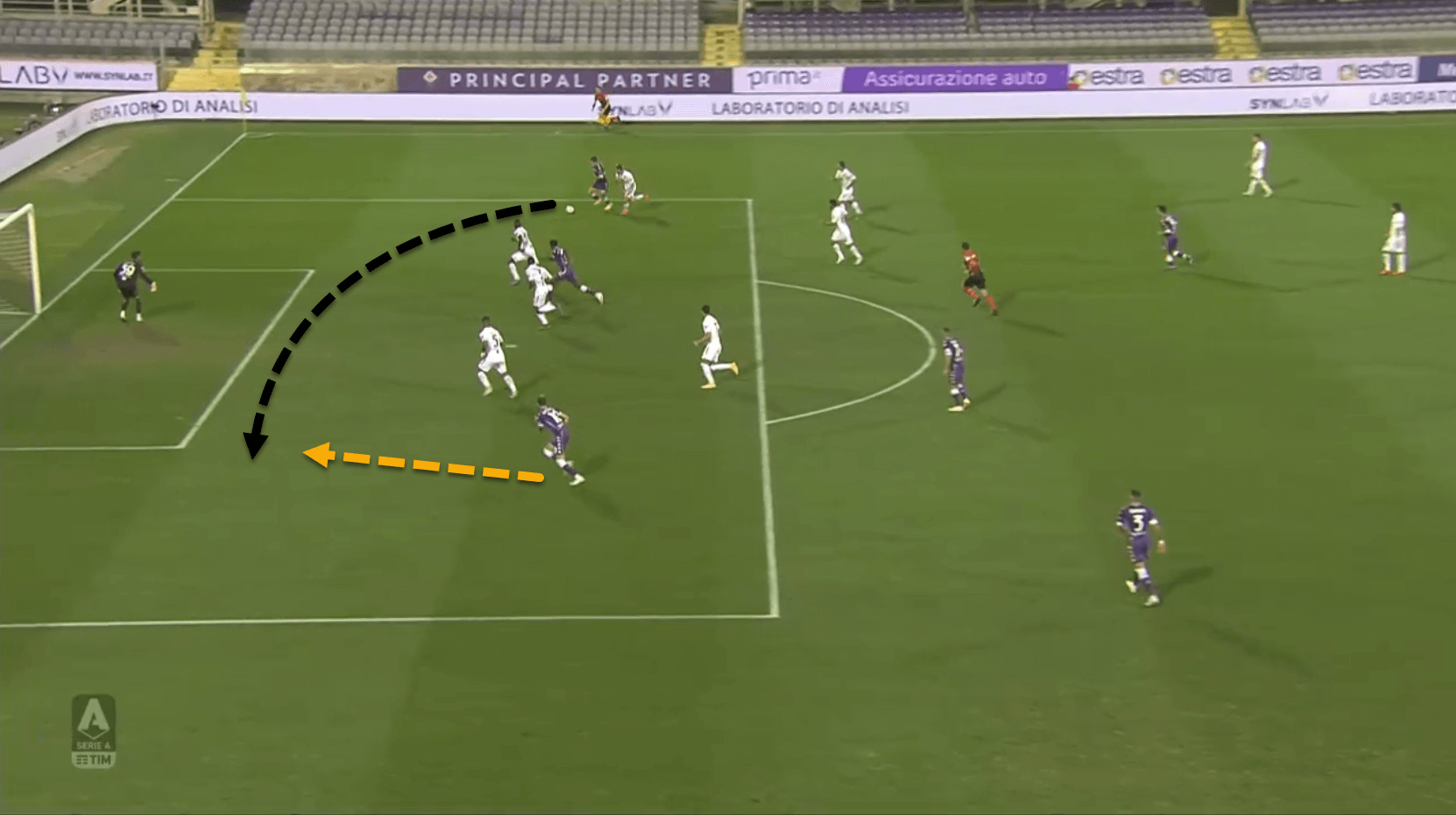
An excellent dribble past the defender and a brilliant cross to the back-post for Castrovilli to tap home gave the three points to La viola.
Torino’s lack of creativity:
Torino severely lacked any creativity in this game. We spoke before about their struggles in the build-up phase, however, once they got past Fiorentina’s press, they did nothing with the ball.
From 369 completed passes in the game, 73 were back-passes. 124 were lateral passes. Only 37 were progressive passes, with just 18 being passes to the final third. They relied on long balls a lot throughout the game to progress up the pitch, playing a total of 52 long passes. They were also dreadful with their crosses, putting in six in total, with none hitting a white shirt.
When they played long, they deployed the same pattern of play used by them last season. As they play a two-striker system, when the ball is played long, both strikers split wide and make runs into the channels. The attacking midfielder follows the ball, making runs in behind the centre-forward, hoping for a flick-on to set him through on goal. This exact move can be seen against Fiorentina here;
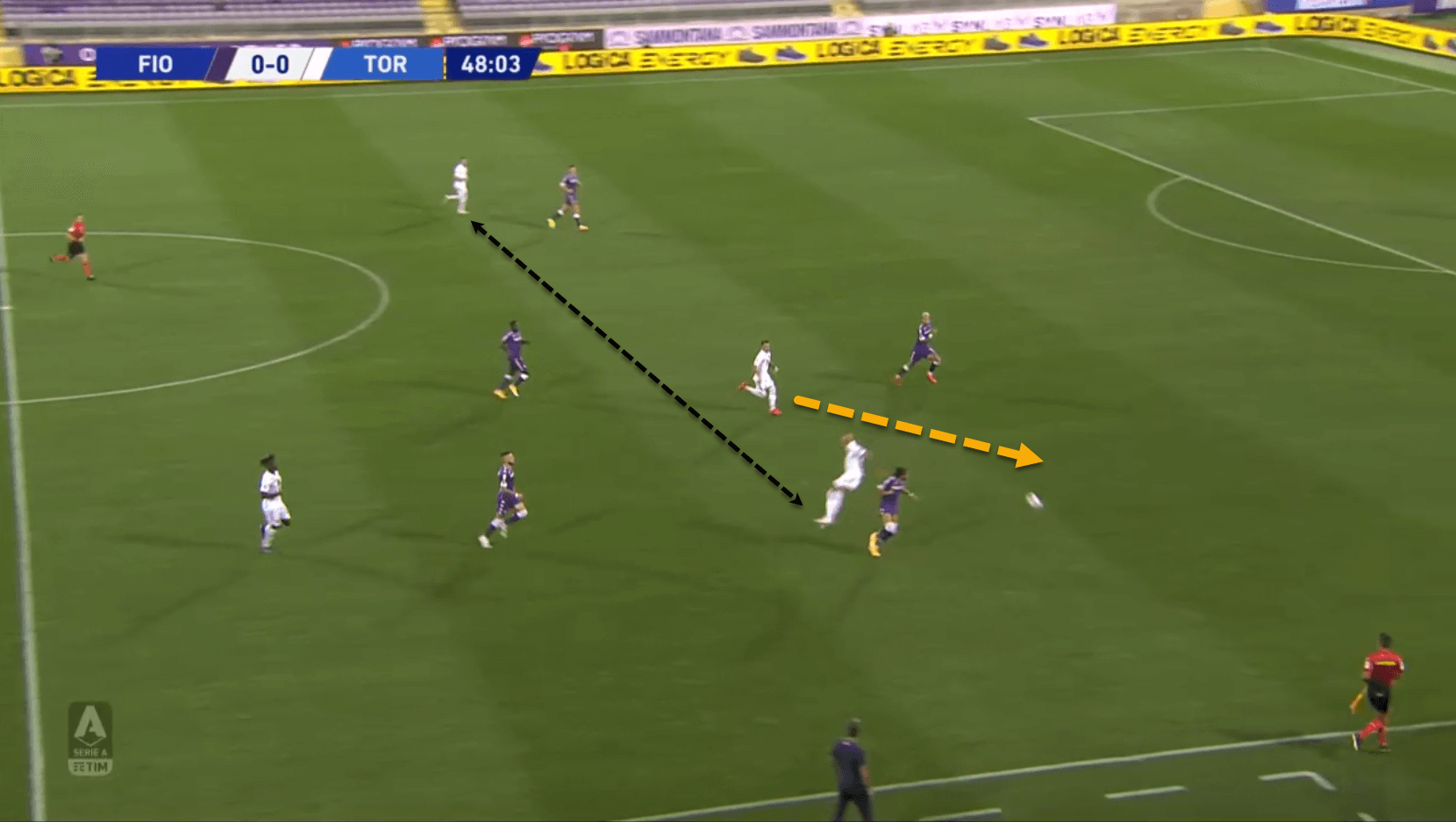
Here, we can see Zaza has made a run into the channel and flicked on the ball. Berenguer has already started to make a run in-behind him to collect the ball from the second ball. Belotti has split from Zaza on the far left. This is to stretch the Fiorentina backline, which in this instance, has worked well for Torino.
As stated before, the major problem with this was that Belotti and Zaza only won a combined total of 40 percent of their aerial duels. Fiorentina’s centre-backs were far more potent with their aerial duels, winning 62 percent of them, and thus, winning the physical battle.
Conclusion:
Torino have a long way to go before they reach the heights of playing European football again. Giampaolo is clearly trying to implement his philosophy, which could be vividly seen throughout this game with their build-up play, etc. However, their lack of creativity is frightening. There are still so many old habits, such as playing long balls, that Torino will need to iron out as soon as possible. Nonetheless, they were far better defensively than they have been under previous managers. Torino won 55 percent of their 80 aerial duels. This shows that the switch to the back four has aided them defensively, if not going forward.
Fiorentina, on the other hand, will be delighted with how the match turned out. They won the tight game by one goal and looked excellent going forward, as well as defensively. Iachini will be delighted with his team’s performance and will hope that they can continue this good run of form going into Saturday’s difficult match against Inter.



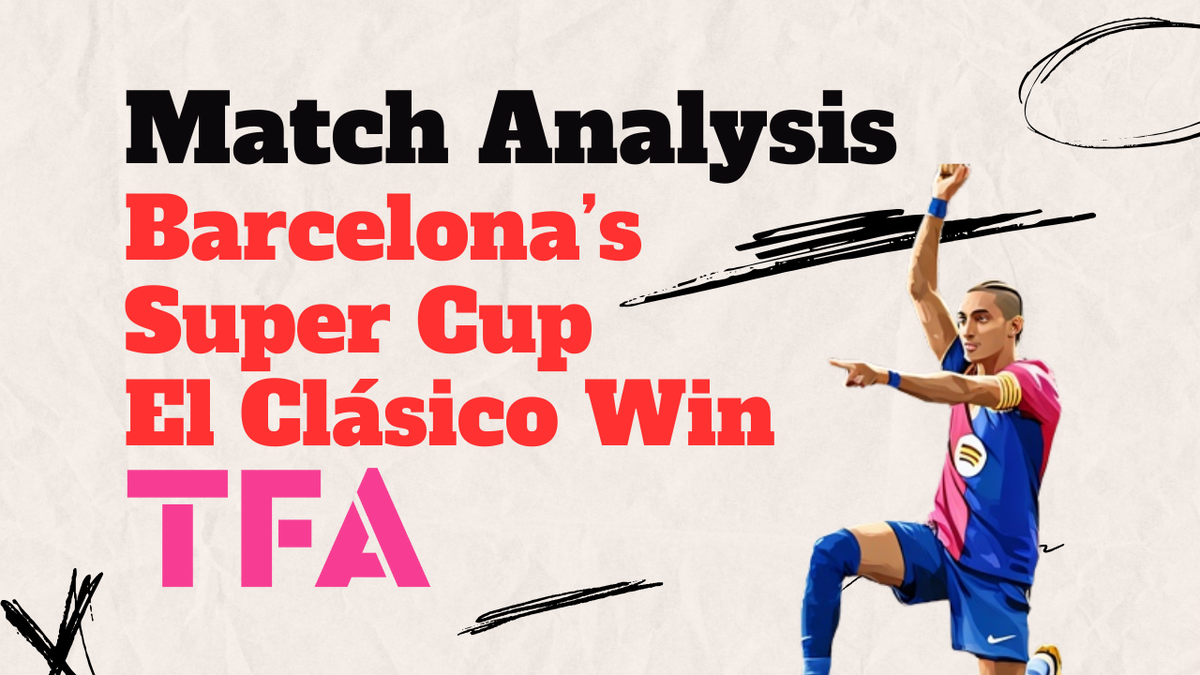
Comments